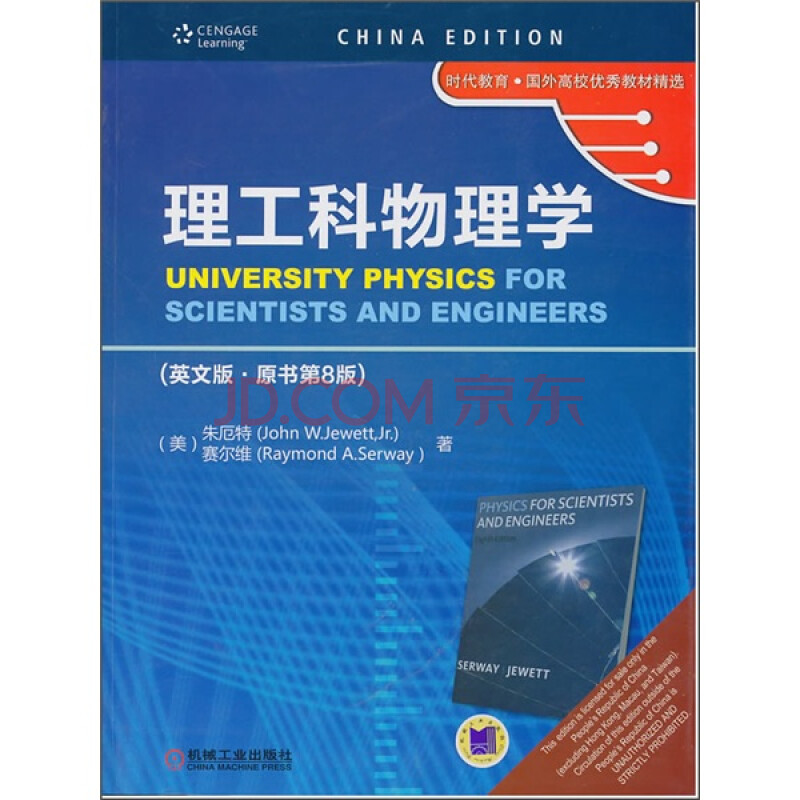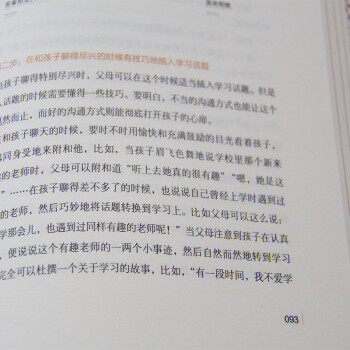热门推荐商品
-
神奇的逻辑思维游戏书 5-13岁提升孩子逻辑思维训练
¥22.50
-
正面管教 修订版 如何不惩罚不娇纵有效管教孩子 育儿百科 最温柔的教养 樊登 早教书
¥19.00
-
一本书读懂中国茶
¥24.90
-
中国国家地理:最好的时光在路上
¥24.90
-
正面管教儿童行为心理学
¥19.00
-
正面管教男孩100招(养育男孩全书)父母的语言话术
¥18.00
-
陪孩子度过7~9岁叛逆期(7-9岁关键养育 叛逆不是孩子的错 男孩女孩自驱型成长)
¥16.30
-
女生呵护指南
¥39.00
-
西尔斯怀孕百科
¥41.50
-
协和医院专家教你吃对不生病:糖尿病吃什么宜忌速查
¥14.90
- 商品名称:理工科物理学(英文版)(原书第8版)
- 商品编号:10481152
产品特色
随着我国加入WTO,国际间的竞争越来越激烈,而国际间的竞争实际上也就是人才的竞争、教育的竞争。为了加快培养具有国际竞争力的高水平技术人才,加快我国教育改革的步伐,国家教育部出台了一系列倡导高校开展双语教学、引进原版教材的政策。以此为契机,机械工业出版社陆续推出了一系列影印版国外优秀教材,其内容涉及高等学校公共基础课,以及机、电、信息领域的专业基础课和专业课。引进国外优秀原版教材,在有条件的学校推动和开展英语授课或双语教学的同时,自然也引进了先进的教学思想和教学方法,这对提高我国自编教材的水平,加强学生的英语实际应用能力,使我国的高等教育尽快与国际接轨,必将起到积极的推动作用。
为了做好教材的引进工作,机械工业出版社特别成立了由著名专家组成的国外高校优秀教材审定委员会。这些专家对实施双语教学做了深入细致的调查研究,对引进原版教材提出了许多建设性意见,并慎重地对每一本将要引进的原版教材一审再审,精选再精选,确认教材本身的质量水平,以及权威性和先进性,以期所引进的原版教材能适应我国学生的外语水平和学习特点。在引进工作中,审定委员会还结合我国高校教学课程体系的设置和要求,对原版教材的教学思想和方法的先进性、科学性严格把关,同时尽量考虑原版教材的系统性和经济性。
这套教材出版后,我们将及时地将其推荐给各高校选用,并将根据各高校的双语教学计划,举办原版教材的教师培训。希望高校师生在使用教材后及时反馈意见和建议,使我们更好地为教学改革服务。
内容简介
《理工科物理学(英文版·原书第8版)》的两大编写原则:就物理学的基本概念和基本原理为学生提供一个清晰、富有逻辑性的讲解:通过大量、有趣的日常生活中的真实例子加强读者对基本概念及原理的理解全书涵盖了经典物理学的基本内容,并简要介绍了近代物理学的内容,共分6部分:牛顿力学及流体;碰撞、机械波及声学;热力学;电学和磁学;光学相对论。《理工科物理学(英文版·原书第8版)》的整体风格是强调“易学”,注重启发性、紧密联系生活实际,主要特色有:“General Problem-Solving Strategy”为读者提供了一个解答一般性题目的详尽方法,并将这种解题方法贯穿在全书的每个例题中;
大约1/3的例题都包含“What If?”这样的问题,即在解题完成后,改变题目中的某些条件,让读者考虑各个待求量会相应地如何变化这有助于鼓励读者去思考例题的结果,而且也能帮助他们对原理进行概念性的理解:
贯穿在书中的大量的“Quick Quiz”可用来检验读者对物理概念的掌握程度;
《理工科物理学(英文版·原书第8版)》提供的两百多个“Pitfall Preventions”能帮助读者在学习中尽量避免常见错误和误解。
《理工科物理学(英文版·原书第8版)》可作为高等院校理工科各专业的大学物理双语课教材。也可供相关教师及自学爱好者参考之用。
目录
PrefacePART 1: MECHANICS
1.Physics and Measurement
1.1 Standards of Length, Mass, and Time
1.2 Matter and Model Building
1.3 Dimensional Analysis
1.4 Conversion of Units
1.5 Estimates and Order-of-Magnitude Calculations
1.6 Significant Figures
Summary
Objective Questions
Conceptual Questions
Problems
2.Motion in One Dimension
2.1 Position, Velocity, and Speed
2.2 Instantaneous Velocity and Speed
2.3 Analysis Model: Particle Under Constant Velocity
2.4 Acceleration
2.5 Motion Diagrams
2.6 Analysis Model: Particle Under Constant Acceleration
2.7 Freely Falling Objects
2.8 Kinematic Equations Derived from Calculus
Summary
Objective Questions
Conceptual Questions
Problems
3.Vectors
3.1 Coordinate Systems
3.9 Vector and Scalar Quantities
3.3 Some Properties of Vectors
3.4 Components of a Vector and Unit Vectors
Summary
Objective Questions
Conceptual Questions
Problems
4.Motion in Two Dimensions
4.1 The Position, Velocity, and Acceleration Vectors
4.2 Two-Dimensional Motion with Constant Acceleration
4.3 Projectile Motion
4.4 Analysis Model: Particle in Uniform Circular Motion
4.5 Tangential and Radial Acceleration
4.6 Relative Velocity and Relative Acceleration
Summary
Objective Questions
Conceptual Questions
Problems
5.The Laws of Motion
5.1 The Concept of Force
5.2 Newtons First Law and Inertial Frames
5.3 Mass
5.4 Newtons Second Law
5.5 The Gravitational Force and Weight
5.6 Newtons Third Law
5.7 Analysis Models Using Newtons Second Law
5.8 Forces of Friction
Summary
Objective Questions
Conceptual Questions
Problems
6.Circular Motion and Other Applications of Newtons Laws
6.1 Extending the Particle in Uniform Circular Motion Model
6.2 Nonuniform Circular Motion
6.3 Motion in Accelerated Frames
6.4 Motion in the Presence of Resistive Forces
Summary
Objective Questions
Conceptual Questions
Problems
7.Energy of a System
7.1 Systems and Environments
7.2 Work Done by a Constant Force
7.3 The Scalar Product of Two Vectors
7.4 Work Done by a Varying Force
7.5 Kinetic Energy and the Work-Kinetic Energy Theorem
7.6 Potential Energy of a System
7.7 Conservative and Nonconservative Forces
7.8 Relationship Between Conservative Forces and Potential Energy
7.9 Energy Diagrams and Equilibrium of a
System
Summary
Objective Questions
Conceptual Questions
Problems
8.Conservation of Energy
8.1 Analysis Model: Nonisolated System (Energy)
8.2 Analysis Model: Isolated System (Energy)
8.3 Situations Involving Kinetic Friction
8.4 Changes in Mechanical Energy for Nonconser-vative Forces
8.5 Power
Summary
Objective Questions
Conceptual Questions
Problems
9.Linear Momentum and Collisions
9.1 Linear Momentum
9.2 Analysis Model: Isolated System (Momentum)
9.3 Analysis Model: Nonisolated System (Momentum)
9.4 Collisions in One Dimension
9.5 Collisions in Two Dimensions
9.6 The Center of Mass
9.7 Systems of Many Particles
9.8 Deformable Systems
9.9 Rocket Propulsion
Summary
Objective Questions
Conceptual Questions
Problems
10. Rotation of a Rigid Object About a Fixed Axis
10.1 Angular Position, Velocity, and Acceleration
10.2 Analysis Model: Rigid Object Under Constant Angular Acceleration
10.3 Angular and Translational Quantities
10.4 Rotational Kinetic Energy
10.5 Calculation of Moments of Inertia
10.6 Torque
10.7 Analysis Model: Rigid Object Under a Net Torque
10.8 Energy Considerations in Rotational Motion
10.9 Rolling Motion of a Rigid Object
Summary
Objective Questions
Conceptual Questions
Problems
11. Angular Momentum
11.1 The Vector Product and Torque
11.2 Analysis Model: Nonisolated System (Angular Momentum)
11.3 Angular Momentum of a Rotating Rigid Object
11.4 Analysis Model: Isolated System (Angular Momentum)
11.5 The Motion of Gyroscopes and Tops
Summary
Objective Questions
Conceptual Questions
Problems
12. Static Equilibrium and Elasticity
12.1 Analysis Model: Rigid Object in Equilibrium
12.2 More on the Center of Gravity
12.3 Examples of Rigid Objects in Static Equilibrium
12.4 Elastic Properties of Solids
Summary
Objective Questions
Conceptual Questions
Problems
13. Universal Gravitation
13.1 Newtons Law of Universal Gravitation
13.2 Free-Fall Acceleration and the Gravitational Force
13.3 Keplers Laws and the Motion of Planets
13.4 The Gravitational Field
13.5 Gravitational Potential Energy
13.6 Energy Considerations in Planetary and
Satellite Motion
Summary
Objective Questions
Conceptual Questions
Problems
14. Fluid Mechanics
14.1 Pressure
14.2 Variation of Pressure with Depth
14.3 Pressure Measurements
14.4 Buoyant Forces and Archimedess Principle
14.5 Fluid Dynamics
14.6 Bernoullis Equation
14.7 Other Applications of Fluid Dynamics
Summary
Objective Questions
Conceptual Questions
Problems
PART 2: OSCILLATIONS AND MECHANICAL WAVES
15. Oscillatory Motion
15.1 Motion of an Object Attached to a Spring
15.2 Analysis Model: Particle in Simple Harmonic Motion
15.3 Energy of the Simple Harmonic Oscillator
15.4 Comparing Simple Harmonic Motion with Uniform Circular Motion
15.5 The Pendulum
15.6 Damped Oscillations
15.7 Forced Oscillations
Summary
Objective Questions
Conceptual Questions
Problems
16. Wave Motion494
16.1 Propagation of a Disturbance
16.2 Analysis Model: Traveling Wave
16.3 The Speed of Waves on Strings
16.4 Reflection and Transmission
16.5 Rate of Energy Transfer by Sinusoidal Waves onStrings
16.6 The Linear Wave Equation
Summary
Objective Questions
Conceptual Questions
Problems
17. Sound Waves
17.1 Pressure Variations in Sound Waves
17.2 Speed of Sound Waves
17.3 Intensity of Periodic Sound Waves
17.4 The Doppler Effect
Summary
Objective Questions
Conceptual Questions
Problems
18. Superposition and Standing Waves
18.1 Analysis Model: Waves in Interference
18.2 Standing Waves
18.3 Analysis Model: Waves Under Boundary Conditions
18.4 Resonance
18.5 Standing Waves in Air Columns
18.6 Standing Waves in Rods and Membranes
18.7 Beats: Interference in Time
18.8 Nonsinusoidal Wave Patterns
Summary
Objective Questions
Conceptual Questions
Problems
PART 3: THERMODYNAMICS
19. Temperature
19.1 Temperature and the Zeroth Law of Thermodynamics
19.2 Thermometers and the Celsius Temperature Scale
19.3 The Constant-Volume Gas Thermometer and the Absolute Temperature Scale
19.4 Thermal Expansion of Solids and Liquids
19.5 Macroscopic Description of an Ideal Gas
Summary
Objective Questizons
Conceptual Questions
Problems
20. The First Law of Thermodynamics
20.1 Heat and Internal Energy
20.2 Specific Heat and Calorimetry
20.3 Latent Heat
20.4 Work and Heat in Thermodynamic Processes
20.5 The First Law of Thermodynamics
20.6 Some Applications of the First Law of Thermodynamics
20.7 Energy Transfer Mechanisms in Thermal Processes
Summary
Objective Questions
Conceptual Questions
Problems
21. The Kinetic Theory of Gases
21.1 Molecular Model of an Ideal Gas
21.2 Molar Specific Heat of an Ideal Gas
21.3 Adiabatic Processes for an Ideal Gas
21.4 The Equipartition of Energy
21.5 Distribution of Molecular Speeds
Summary
Objective Questions
Conceptual Questions
Problems
22. Heat Engines, Entropy, and the Second Law of Thermodynamics
22.1 Heat Engines and the Second Law of Thermodynamics
22.2 Heat Pumps and Refrigerators
22.3 Reversible and Irreversible Processes
22.4 The Carnot Engine
22.5 Gasoline and Diesel Engines
22.6 Entropy
22.7 Entropy and the Second Law
22.8 Entropy on a Microscopic Scale
Summary
Objective Questions
Conceptual Questions
Problems
PART 4: ELECTRICITY AND MAGNETISM
23. Electric Fields
23.1 Properties of Electric Charges
23.2 Charging Objects by Induction
23.3 Coulombs Law
23.4 The Electric Field
23.5 Electric Field of a Continuous Charge Distribution
23.6 Electric Field Lines
23.7 Motion of a Charged Particle in a Uniform Electric Field
Summary
Objective Questions
Conceptual Questions
Problems
24.Gauss,SLaw
24.1 Electric Flux
24.2 Gauss’s Law
24.3 Application of Gauss’s Law to Various Charge Distributions
24.4 Conductors in Electrostatic Equilibrium
Summary
Objective Questions
Conceptual Questions
Problems
25.Electric Potential
25.1 Electric Potential and Potential Difference
25.2 Potential Difrerence in a Uniform Electric Field
25.3 Electric Potential and Potential Energy Due to Point Charges
25.4 Obtaining the Value of the Electric Field from the Electric Potential
25.5 Electric Potential DHe to Continuous Charge Distributions
25.6 Electric Potential DHe to a Charged Conductor
25.7 The Millikan Oil-Drop Experiment
25.8 Applications of Electrostatics
Summary
Objective Ouestions
Conceptual Questions
Problems
26.Capacitance and Dielectrics
26.1 Deftnition of Capacitance
26.2 Calculating Capacitance
26.3 Combinations of Capacitors
26.4 Energy Stored in a Charged Capacitor
26.5 Capacitors with Dielectrics
26.6 Electric Dipole in an Electric Field
26.7 An Atomic Description of Dielectrics
Summary
Objective Questions
Conceptual Questions
Problems
27.Current and Resistance
27.1 Electric Current.
27.2 Resistance
27.3 A Model for Electrical Conduction
27.4 Resistance and Temperature
27.5 Superconductors
27.6 Electrical Power
Summary
Objective Questions
Conceptual Questions
Problems
28.Direct-Current Circuits
28.1 Electromotive Force
28.2 Resistors in Series and Parallel
28.3 Kirchhoff’s Rules
28.4 RC Circuits
28.5 Household Wiring and Electrical Safetv
Summary
Objective Questions
Conceptual Questions
Problems
29.Magnetic Fields
29.1 Magnetic Fields and Forces
29.2 Motion of a Charged Particle in a UnifcIrm Magnetic Field
29.3 Applications Involving Charged Particles Moving in a Magnetic Field
29.4 Magnetic Force Acting on a Current.Carrying Conductor
29.5 Torque on a Current Loop in a Uniform Magnetic Field
29.6 The Hall Eflbct
Summary
Objective Questions
Conceptual Questions
Problems
30.Sources of the Magnetic Field
30.1 The Biot-SavartLaw
30.2 The Magnetic Force Between Two Parallel Conductors
30.3 Ampere’s Law
30.4 The Magnetic Field of a Solenoid
30.5 GRUSS’s Law in Magnetism
30.6 Magnetism in Matter
Summary
Objective Questions
Conceptual Questions
Problems
31.FaradaysLaw
31.1 Faraday’s Law of Induction
31.2 Motional emf
31.3 Lenz’sLaw
31.4 Induced emf and Electric Fields
31.5 Generators and Motors
31.6 Eddy Currents
Summary
Objective Questions
Conceptual Questions
Problems
32.Inductance
32.1 Self-Induction and Inductance
32.2 RL Circuits
32.3 Energy in a Magnetic Field
32.4 Mutual Inductance
32.5 Oscillations in an LC Circuit
32.6 The RLC Circuit
Summary
Objective Questions
Conceptual Questions
Problems
33.Alternating-Current Circuits
33.1 AC Sources
33.2 Resistors in an AC Circuit
33.3 Tndllctors in an Ar Gircuit
……
精彩书摘
This method is somewhat similar to the common practice in the legal profession of finding“legal precedents.” If a previously resolved case can be found that is very similar legally to the current one,it is used as a model and an argument is made in court to link them logically.The finding in the previous case can then be used to sway the finding in the current case.We will do something similar in physics.For a given problem,we search for a“physics precedent,”a model with which we are already familiar and that can be applied to the current problem. We shall generate analysis models based on fomr fundamental simplification models.The first of the four is the particle model discussed in the introduction to this chapter.We will look at a particle under various behaviors and environmental interactions.Further analysis models are introduced in later chapters based on simplification models of a ststem,a rigid object, and a wave.0nee we have introduced these analysis roodels.we shall see that they appear again and again in different problem situations.When solving a problem,you should avoid browsing through the chapter looking for an equation that contains the unknown variable that is requested in the problem.In many cases,the equation you find may have nothing to do with the problem you are attempting to solve.It is much better to take this first step:Identifv the analysis model that is appropriate for the problem.To do so,think carefully about what is going on in the problem and match it to a situation you have seen be fore.0nce the analysis model is identified,there are a small number of equations from which to choose that are appropriate for that model.There fore,the model tells you which equation(s)to use for the
mathematical representation.
Let us use Equation 2.2 to build our first analysis model for solving problems.We imagine a particle moving with a constant velocity.The roodel of a particle under constant velocity can be applied in any situation in which an entiw that can be modeled as a particle is moving with constant velocity.This situation Occurs frequently,so this model is important.


















 沪公网安备 31010402003631号
沪公网安备 31010402003631号